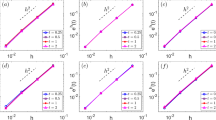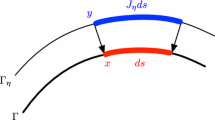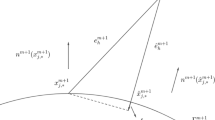Abstract
We propose and analyze a structure-preserving parametric finite element method (SP-PFEM) for the evolution of a closed curve under different geometric flows with arbitrary anisotropic surface energy density \(\gamma (\varvec{n})\), where \(\varvec{n}\in \mathbb {S}^1\) represents the outward unit normal vector. We begin with the anisotropic surface diffusion which possesses two well-known geometric structures—area conservation and energy dissipation—during the evolution of the closed curve. By introducing a novel surface energy matrix \(\varvec{G}_k(\varvec{n})\) depending on \(\gamma (\varvec{n})\) and the Cahn-Hoffman \(\varvec{\xi }\)-vector as well as a nonnegative stabilizing function \(k(\varvec{n})\), we obtain a new conservative geometric partial differential equation and its corresponding variational formulation for the anisotropic surface diffusion. Based on the new weak formulation, we propose a full discretization by adopting the parametric finite element method for spatial discretization and a semi-implicit temporal discretization with a proper and clever approximation for the outward normal vector. Under a mild and natural condition on \(\gamma (\varvec{n})\), we can prove that the proposed full discretization is structure-preserving, i.e. it preserves the area conservation and energy dissipation at the discretized level, and thus it is unconditionally energy stable. The proposed SP-PFEM is then extended to simulate the evolution of a close curve under other anisotropic geometric flows including anisotropic curvature flow and area-conserved anisotropic curvature flow. Extensive numerical results are reported to demonstrate the efficiency and unconditional energy stability as well as good mesh quality (and thus no need to re-mesh during the evolution) of the proposed SP-PFEM for simulating anisotropic geometric flows.









Similar content being viewed by others
References
Andrews, B.: Volume-preserving anisotropic mean curvature flow. Indiana Univ. Math. J., 783-827 (2001)
Bao, W., Garcke, H., Nürnberg, R., Zhao, Q.: Volume-preserving parametric finite element methods for axisymmetric geometric evolution equations. J. Comput. Phys. 460, 111180 (2022)
Bao, W., Garcke, H., Nürnberg, R., Zhao, Q.: A structure-preserving finite element approximation of surface diffusion for curve networks and surface clusters. Numer. Methods Partial Differ. Equ. 39, 759–794 (2023)
Bao, W., Jiang, W., Li, Y.: A symmetrized parametric finite element method for anisotropic surface diffusion of closed curves. SIAM J. Numer. Anal. 61(2), 617–641 (2023)
Bao, W., Jiang, W., Wang, Y., Zhao, Q.: A parametric finite element method for solid-state dewetting problems with anisotropic surface energies. J. Comput. Phys. 330, 380–400 (2017)
Bao, W., Li, Y.: A symmetrized parametric finite element method for anisotropic surface diffusion in three dimensions. SIAM J. Sci. Comput. 45(4), A1438–A1461 (2023)
Bao, W., Zhao, Q.: An energy-stable parametric finite element method for simulating solid-state dewetting problems in three dimensions. J. Comput. Math. 41, 771–796 (2023)
Bao, W., Zhao, Q.: A structure-preserving parametric finite element method for surface diffusion. SIAM J. Numer. Anal. 59(5), 2775–2799 (2021)
Barrett, J.W., Garcke, H., Nürnberg, R.: A parametric finite element method for fourth order geometric evolution equations. J. Comput. Phys. 222(1), 441–467 (2007)
Barrett, J.W., Garcke, H., Nürnberg, R.: Numerical approximation of anisotropic geometric evolution equations in the plane. IMA J. Numer. Anal. 28(2), 292–330 (2008)
Barrett, J.W., Garcke, H., Nürnberg, R.: On the parametric finite element approximation of evolving hypersurfaces in \(\mathbb{R} ^3\). J. Comput. Phys. 227(9), 4281–4307 (2008)
Barrett, J.W., Garcke, H., Nürnberg, R.: A variational formulation of anisotropic geometric evolution equations in higher dimensions. Numer. Math. 109(1), 1–44 (2008)
Barrett, J.W., Garcke, H., Nürnberg, R.: Finite-element approximation of coupled surface and grain boundary motion with applications to thermal grooving and sintering. Eur. J. Appl. Math. 21(6), 519–556 (2010)
Barrett, J.W., Garcke, H., Nürnberg, R.: Parametric finite element approximations of curvature-driven interface evolutions. Handb. Numer. Anal. 21, 275–423 (2020)
Cahn, J.: Stability, microstructural evolution, grain growth, and coarsening in a two-dimensional two-phase microstructure. Acta Metall. Mater. 39(10), 2189–2199 (1991)
Cahn, J.W., Taylor, J.E.: Overview no. 113 surface motion by surface diffusion. Acta Metall. Mater. 42(4), 1045–1063 (1994)
Carter, W.C., Roosen, A., Cahn, J.W., Taylor, J.E.: Shape evolution by surface diffusion and surface attachment limited kinetics on completely faceted surfaces. Acta Metall. Mater. 43(12), 4309–4323 (1995)
Chen, Y., Giga, Y., Goto, S.: Uniqueness and existence of viscosity solutions of generalized mean curvature flow equations. In: Fundamental Contributions to the Continuum Theory of Evolving Phase Interfaces in Solids, pp. 375–412. Springer, Berlin (1999)
Clarenz, U., Diewald, U.,Rumpf, M.: Anisotropic geometric diffusion in surface processing. IEEE Vis. (2000)
Deckelnick, K., Dziuk, G., Elliott, C.M.: Computation of geometric partial differential equations and mean curvature flow. Acta Numer. 14, 139–232 (2005)
Deckelnick, K., Dziuk, G., Elliott, C.M.: Fully discrete finite element approximation for anisotropic surface diffusion of graphs. SIAM J. Numer. Anal. 43(3), 1112–1138 (2005)
Dolcetta, I.C., Vita, S.F., March, R.: Area-preserving curve-shortening flows: from phase separation to image processing. Interfaces Free Bound. 4(4), 325–343 (2002)
Du, P., Khenner, M., Wong, H.: A tangent-plane marker-particle method for the computation of three-dimensional solid surfaces evolving by surface diffusion on a substrate. J. Comput. Phys. 229(3), 813–827 (2010)
Du, Q., Feng, X.: The phase field method for geometric moving interfaces and their numerical approximations. Handb. Numer. Anal 21, 425–508 (2020)
Dziuk, G.: An algorithm for evolutionary surfaces. Numer. Math. 58(1), 603–611 (1990)
Dziuk, G.: Convergence of a semi-discrete scheme for the curve shortening flow. Math. Models Methods Appl. Sci. 04(4), 589–606 (1994)
Fonseca, I., Pratelli, A., Zwicknagl, B.: Shapes of epitaxially grown quantum dots. Arch. Ration. Mech. Anal. 214, 359–401 (2014)
Girao, P.M., Kohn, R.V.: The crystalline algorithm for computing motion by curvature. In: Variational Methods for Discontinuous Structures, pp. 7–18. Springer, Berlin (1996)
Gurtin, M.E., Jabbour, M.E.: Interface evolution in three dimensions with curvature-dependent energy and surface diffusion: interface-controlled evolution, phase transitions, epitaxial growth of elastic films. Arch. Ration. Mech. Anal. 163, 171–208 (2002)
Hoffman, D.W., Cahn, J.W.: A vector thermodynamics for anisotropic surfaces: I. Fundamentals and application to plane surface junctions. Surf. Sci. 31, 368–388 (1972)
Jiang, W., Bao, W., Thompson, C.V., Srolovitz, D.J.: Phase field approach for simulating solid-state dewetting problems. Acta Mater. 60(15), 5578–5592 (2012)
Jiang, W., Wang, Y., Zhao, Q., Srolovitz, D.J., Bao, W.: Solid-state dewetting and island morphologies in strongly anisotropic materials. Scr. Mater. 115, 123–127 (2016)
Jiang, W., Zhao, Q.: Sharp-interface approach for simulating solid-state dewetting in two dimensions: A Cahn-Hoffman \(\varvec {\xi }\)-vector formulation. Phys. D 390, 69–83 (2019)
Kovács, B., Li, B., Lubich, C.: A convergent evolving finite element algorithm for mean curvature flow of closed surfaces. Numer. Math. 143, 797–853 (2019)
Li, Y., Bao, W.: An energy-stable parametric finite element method for anisotropic surface diffusion. J. Comput. Phys. 446, 110658 (2021)
Mercier, G., Novaga, M., Pozzi, P.: Anisotropic curvature flow of immersed curves. Commun. Anal. Geom. 27(4), 937–964 (2019)
Niessen, W.J., Romeny, B.M., Florack, L.M., Viergever, M.A.: A general framework for geometry-driven evolution equations. Int. J. Comput. Vis. 21(3), 187–205 (1997)
Perl, R., Pozzi, P., Rumpf, M.: A Nested Variational Time Discretization for Parametric Anisotropic Willmore Flow, pp. 221–241. Springer International Publishing, Berlin (2014)
Randolph, S., Fowlkes, J., Melechko, A., Klein, K., Meyer, I., Simpson, M., Rack, P.: Controlling thin film structure for the dewetting of catalyst nanoparticle arrays for subsequent carbon nanofiber growth. Nanotech. 18(46), 465354 (2007)
Shen, H., Nutt, S., Hull, D.: Direct observation and measurement of fiber architecture in short fiber-polymer composite foam through micro-CT imaging. Compos. Sci. Technol. 64(13–14), 2113–2120 (2004)
Sutton, A.P., Balluffi, R.W.: Interfaces in Crystalline Materials. Clarendon Press, Oxford (1995)
Taylor, J.E.: Mean curvature and weighted mean curvature. Acta Metall. Mater. 40, 1475–1485 (1992)
Taylor, J.E., Cahn, J.W., Handwerker, C.A.: Overview no. 98 i–geometric models of crystal growth. Acta Metall. Mater. 40(7), 1443–1474 (1992)
Thompson, C.V.: Solid-state dewetting of thin films. Annu. Rev. Mater. Res. 42, 399–434 (2012)
Wang, Y., Jiang, W., Bao, W., Srolovitz, D.J.: Sharp interface model for solid-state dewetting problems with weakly anisotropic surface energies. Phys. Rev. B 91(4), 045303 (2015)
Wheeler, A.: Cahn-Hoffman \(\varvec {\xi }\)-vector and its relation to diffuse interface models of phase transitions. J. Stat. Phys. 95, 1245–1280 (1999)
Wong, H., Voorhees, P., Miksis, M., Davis, S.: Periodic mass shedding of a retracting solid film step. Acta Mater. 48(8), 1719–1728 (2000)
Xu, Y., Shu, C.: Local discontinuous Galerkin method for surface diffusion and Willmore flow of graphs. J. Sci. Comput. 40(1–3), 375–390 (2009)
Ye, J., Thompson, C.V.: Mechanisms of complex morphological evolution during solid-state dewetting of single-crystal nickel thin films. Appl. Phys. Lett. 97(7), 071904 (2010)
Zhao, Q., Jiang, W., Bao, W.: An energy-stable parametric finite element method for simulating solid-state dewetting. IMA J. Numer. Anal. 41(3), 2026–2055 (2021)
Acknowledgements
This work was partially supported by the Ministry of Education of Singapore under its AcRF Tier 2 funding MOE-T2EP20122-0002 (A-8000962-00-00). Part of the work was done when the authors were visiting the Institute of Mathematical Science at the National University of Singapore in 2023.
Author information
Authors and Affiliations
Corresponding author
Additional information
Publisher's Note
Springer Nature remains neutral with regard to jurisdictional claims in published maps and institutional affiliations.
Rights and permissions
Springer Nature or its licensor (e.g. a society or other partner) holds exclusive rights to this article under a publishing agreement with the author(s) or other rightsholder(s); author self-archiving of the accepted manuscript version of this article is solely governed by the terms of such publishing agreement and applicable law.
About this article
Cite this article
Bao, W., Li, Y. A structure-preserving parametric finite element method for geometric flows with anisotropic surface energy. Numer. Math. 156, 609–639 (2024). https://doi.org/10.1007/s00211-024-01398-8
Received:
Revised:
Accepted:
Published:
Issue Date:
DOI: https://doi.org/10.1007/s00211-024-01398-8




